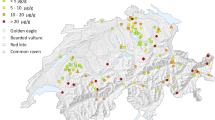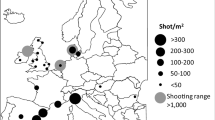Abstract
We examined the degree of lead exposure, based on tissue-lead concentrations, in 184 raptors of 16 species found dead across Canada. The most prevalent species available for examination were Red-tailed hawks, Great horned owls, and Golden eagles (n=131). The majority of individuals examined had very low lead accumulation, however 3–4% of total mortality in these 3 most commonly encountered species was attributed to lead poisoning. In addition, 1 of 9 Bald Eagles found dead far from aquatic environments was lead poisoned; and a single Turkey Vulture had a highly elevated bone-lead concentration (58 µg/g dry weight). Evidence from our study, along with other published research, indicates that upland-foraging birds of prey and scavengers that typically include game birds and mammals in their diets, are at risk for lead poisoning from the ingestion of lead projectiles from ammunition used in upland hunting. The use of non-lead ammunition for hunting upland game would effectively remove the only serious source of high lead exposure and lead poisoning for upland-foraging raptors.
Similar content being viewed by others
References
Anderson, W.L. (1992). Legislation and lawsuits in the United States and their effects in nontoxic shot regulations. In D.J. Pain (ed) Lead Poisoning in Waterfowl, pp. 56-60. Slimbridge UK: IWRB. Spec. Publ. 16.
Anderson, W.L. and Havera, S.P. (1985). Blood lead, protoporphyrin, and ingested shot for detecting lead poisoning in waterfowl. Wildl. Soc. Bull. 13, 26-31.
Bellrose, F.C. (1953). A preliminary evaluation of crippling losses in waterfowl. Trans. N. Amer. Wildl. Conf. 18, 337-60.
Bezzel, E. and Fünfstück, H.J. (1995). Lead poisoning as a threat to Golden eagles Aquila chrysaetos in the northern Alps? J. Ornith. 136, 294-6.
Bloom, P.H., Scott, J.M., Pattee, O.H. and Smith, M.R. (1989). Lead contamination of golden eagles Aquila chrysaetos within the range of the California condor Gymnogyps californianus. In B.U. Meyburg and R.D. Chancellor (eds) Raptors in the Modern World, Berlin London & Paris: WWGBP.
Boag, D.A. (1977). Summer food habits of Golden Eagles in southwestern Alberta. Can. Field Nat. 91, 296-8.
Collopy, M.W. (1983). A comparison of direct observations and collections of prey remains in determining the diet of Golden Eagles. J. Wildl. Manage. 47, 360-8.
Craig, T.H., Connelly, J.W., Craig, E.H. and Parker, T.L. (1990). Lead concentrations in Golden and Bald eagles. Wil. Bull. 102, 130-3.
Denneman, W.D. and Douben, P.E.T. (1993). Trace metals in primary feathers of the barn owl (Tyto alba guttatus) in the Netherlands. Environ. Pollut. 82, 301-10.
Elder, W.H. (1955). Fluroscope measures of hunting pressure in Europe and North America. Trans. N. Amer. Wildl. Conf. 20, 298-322.
Elliott, J.E., Langelier, K.M., Scheuhammer, A.M., Sinclair, P.H. and Whitehead, P.E. (1992). Incidence of lead poisoning in Bald eagles and lead shot in waterfowl gizzards from British Columbia, 1988–91. Can. Wildl. Serv. Prog. Note No. 200:7 pp.
Environment Canada (1997). Regulations amending the migratory birds regulations. Registration SOR/97-400. Ottawa, canada.
Fitch, H.S., Swenson, F. and Tillotson, D.F. (1946). Behaviour and food habits of the Red-tialed hawk. Condor 48, 205-37.
Frank, A. (1986). Lead fragments in tissues from wild birds: a cause of misleading results. Sci. Total Envrion. 54, 275-81.
Franson, J.C. (1996). Interpretation of tissue lead residues in birds other than waterfowl. In W.N. Beyer, G.H. Heinz, A.W. Redmon-Norwood (eds) Environmental Contaminants in Wildlife: Interpreting Tissue Concentrations, pp. 265-79. New York: CRC Press Lewis Publishers.
Garcia Fernandez, A.J., Motas-Guzman, M., Navas, I., Maria-Mojica, P., Luna, A. and Sanchez-Garcia, J.A. (1997). Environmental exposure and distribution of lead in four species of raptors in southeastern Spain. Arch. Environ. Contam. Toxicol. 33, 76-82.
Garcia-Fernandez, A.J., Sanchez-Garcia, J.A., Jimenez-Montalban, P. and Luna, A. (1995). Lead and cadmium in wild birds in southeastern Spain. Environ. Toxicol. Chem. 14, 2049-58.
Gretz, M. and Bayle, C. (1983/1984). Contamination par le plomb et le cadmium des oiseaux de proie dans l'est de la France. Bull. Assoc. Philomathique d' Alsace 20, 135-61.
Griffin, C.R., Baskett, T.S. and Sparrowe, R.D. (1982). Ecology of Bald Eagles Wintering Near a Waterfowl Concentration. US Fish and Wildlife Service S.S.R., Wildl. No. 247. Washington, D.C. 12 pp.
Henny, C.J., Blus, L.J., Hoffman, D.J. and Grove, R.A. (1994). Lead in hawks, falcons and owls downstream from a mining site on the Coeur d'Alene river, Idaho. Environ. Monitor. Assess. 29, 267-88.
Henny, C.J., Blus, L.J., Hoffman, D.J., Grove, R.A. and Hatfield, J.S. (1991). Lead accumulation and osprey production near a mining site on the Coeur d'Alene River, Idaho. Arch Environ. Contam. Toxicol. 21, 415-24.
Janssen, D.L., Oosterhus, J.E., Allen, J.L., Anderson, M.P., Kelts, D.G. and Wiemeyer, S.N. (1986). Lead poisoning in free ranging California condors. J. Am. Vet. Med. Assoc. 189, 1115-17.
Kendall, R.J., Lacher, T.E., Bunck, C., Daniel, B., Driver, C., Grue, C.E., Leighton, F., Stansley, W., Watanabe, P.G. and Whitworth, M. (1996). An ecological risk assessment of lead shot exposure in non-waterfowl avian species: upland game birds and raptors. Environ. Toxicol. Chem. 15, 4-20.
Kirk, D.A. and Mossman, M.J. (1998). Turkey vulture (Cathartes aura). In A. Poole and F. Gill (eds) The Birds of North America, No. 339, Philadelphia PA: The Birds of North America Inc.
Kramer, J.L. and Redig, P.T. (1997). Sixteen years of lead poisoning in eagles, 1980–95: an epizootiologic view. J. Raptor Res. 31, 327-32.
Lang, A.L., Andres, R.A. and Martin, P.A. (1999). Prey remains in Bald Eagle, Haliaeetus leucocephalus, pellets from winter roost in the upper St. Lawrence River, 1996 and 1997. Can. Field Nat. 113, 621-6.
Lish, J.W. and Lewis, J.C. (1975). Status and ecology of bald eagles wintering in Oklahoma. Proc. Southeastern Assoc. Game Fish Comm. 29, 415-23.
Locke, L.N. and Friend, M. (1992). Lead poisoning of avian species other than waterfowl. In D.J. Pain (ed.) Lead Poisoning in Waterfowl, pp. 19-22. Slimbridge, UK: IWRB. Spec. Publ. No. 16.
Luttich, S., Rusch, D.H., Meslow, E.C. and Keith, L.B. (1970). Ecology of Red-tailed hawk predation in Alberta. Ecology 51, 190-203.
McInvaille, W.B. Jr and Keith, L.B. (1974). Predator-prey relations and breeding biology of the Great Horned Owl and Red-tailed Hawk in central Alberta. Can. Field Nat. 88, 1-20.
Meretsky, V.J., Snyder, N.F.R., Beissinger, S.R., Clendenen, D.A. and Wiley, J.W. (2000). Demography of the California Condor: implications for reestablishment. Conserv. Biol. 14, 957-67.
Nelson, T.A., Mitchell, C. and Abbott, C. (1989). Lead-shot ingestion by bald eagles in Western Arkansas. Southwestern Naturalist 34, 245-9.
Ohlendorff, R.R. (1976). The food habits of North American golden eagles. Amer. Midl. Nat. 95, 231-6.
Pain, D.J. (1992). Lead poisoning of waterfowl: A review. In D.J. Pain (ed.) Lead Poisoning in Waterfowl, pp. 7-13. Slimbridge, UK: IWRB. Spec. Publ. 16.
Pain, D.J. and Amiard-Triquet, C. (1993). Lead poisoning of raptors in France and elsewhere. Ecotox. Environ. Safety 25, 183-92.
Pain, D.J., Sears, J. and Newton, I. (1995). Lead concentrations in birds of prey in Britain. Environ. Pollut. 87, 173-80.
Pattee, O.H., Bloom, P.H., Scott, J.M. and Smith, M.R. (1990). Lead hazards within the range of the California condor. Condor 92, 931-7.
Pattee, O.H. and Hennes, S.K. (1983). Bald eagles and waterfowl: the lead shot connection. Trans. Am. Wildl. Nat. Resour. Conf. 48, 230-7.
Pattee, O.H., Wiemeyer, S.N., Mulhern, B.M., Sileo, L. and Carpenter, J.W. (1981). Experimental lead-shot poisoning in Bald Eagles. J. Wildl. Manage. 45, 806-10.
Platt, J.B. (1976). Bald eagles wintering in a Utah desert. Amer. Birds 30, 783-8.
Redig, P.T., Stowe, C.M., Barnes, D.M. and Arent, T.D. (1980). Lead toxicosis in raptors. J. Am. Vet. Med. Assoc. 177, 941-3.
Reichel, W.L., Schmeling, S.K., Cromartie, E., Kaiser, T.E., Krynitsky, A.J., Lamont, T.G., Mulhern, B.M., Prouty, R.M., Stafford, C.J. and Swineford, D.M. (1984). Pesticide, PCB, and lead residues and necropsy data for bald eagles from 32 states—1978–81. Environ. Monit. Assess. 4, 395-403.
Rusch, D.H., Meslow, E.C., Doerr, P.D. and Keith, L.B. (1972). Response of Great Horned Owl populations to changing prey densities. J. Wildl. Manag. 36, 282-96.
Sanderson, G.C. and Bellrose, F.C. (1986). A review of the problem of lead poisoning in waterfowl. Ill. Nat. Hist. Surv. Spec. Publ. 34 pp.
Scheuhammer, A.M. (1987). The chronic toxicity of aluminum, cadmium, mercury and lead in birds: a review. Environ. Poll. 46, 263-95.
Scheuhammer, A.M. and Dickson, K.M. (1996). Patterns of environmental lead exposure in waterfowl in eastern Canada. Ambio 25, 14-20.
Scheuhammer, A.M. and Norris, S.L. (1995). A review of the environmental impacts of lead shotshell ammunition and lead fishing weights in Canada. Can. Wildl. Serv. Occas, Paper No. 88, Ottawa, Canada. 52 pp.
Scheuhammer, A.M., Perrault, J.A., Routhier, E., Braune, B.M. and Campbell, G.D. (1998). Elevated lead concentrations in edible portions of game birds harvested with lead shot. Environ. Pollut. 102, 251-7.
Sikarskie, J. (1977). The case of the red-tailed hawk. Intervet. 8, 4.
Stendall, R.C. (1980). Dietary exposure of kestrels to lead. J. Wildl. Manage. 44, 527-30.
Stendall, R.C., Smith, R.I., Burnham, K.P. and Christensen, R.E. (1979). Exposure of waterfowl to lead: a nationwide survey of residues in wingbones of seven species 1972–73. USFWS, Spec. Sci. Rep., Wildlife No. 223. Washington DC, 12 pp.
USFWS (1986). Use of lead shot for hunting migratory birds in the United States—Final supplemental environmental impact statement. US Dept. Interior, Washington, DC.
Von Kuster, D.D. and Schneberger, D. (1992) Diet of the Great Horned Owl in central Saskatchewan. Blue Jay 50, 195-200.
Wayland, M. and Bollinger, T. (1999). Lead exposure and poisoning in bald eagles and golden eagles in the Canadian prairie provinces. Environ. Pollut. 104, 341-50.
Wayland, M., Neugebauer, E. and Bollinger, T. (1999). Concentrations of lead in liver, kidney, and bone of Bald and Golden eagles. Arch. Environ. Contam. Toxicol. 37, 267-72.
Weir, D. and Hanson, A. (1989). Food habits of Great horned owls, Bubo virginianus, in the Northern Taiga of the Yukon Territory and Alaska. Can. Field Nat. 103, 12-17.
Wiemeyer, S.N., Jurek, R.M. and Moore, J.F. (1986). Environmental contaminants in surrogates, foods, and feathers of California condors (Gymnogyps californianus). Environ. Monit. Assess. 6, 91-111
Author information
Authors and Affiliations
Corresponding author
Rights and permissions
About this article
Cite this article
Clark, A., Scheuhammer, A. Lead Poisoning in Upland-foraging Birds of Prey in Canada. Ecotoxicology 12, 23–30 (2003). https://doi.org/10.1023/A:1022576510445
Issue Date:
DOI: https://doi.org/10.1023/A:1022576510445




